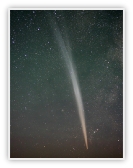



Copyright © All rights reserved. Made By Erik Bryssinck Terms of use | Privacy policy














Comets
What are comets ?
A comet is a small solar system body that orbits the Sun. They excist in many size from some km to tens of km across. So this is the easy answer on that question. So let’s go deeper in this matter of comets
Why tails and what are they ?
Some additional explanation is here certainly necessary. The primary part of the comet is the nucleus, they are composed of rock, dust, ice, and frozen gases such as carbon monoxide, carbon dioxide, methane, ammonia, hydrocarbons… They are first described by Whipple , he wrote a series of influential papers entitled A Comet Models, as ‘dirty snowballs’, but recent observations have revealed dry dusty or rocky surfaces, suggesting that the ices are hidden beneath a crust. Comets also contain a variety of organic compounds in addition to the gases already mentioned, these may include methanol, hydrogen, hydrogen cyanide, formaldehyde, ethanol, and ethane. The nucleus can have several shapes, because the very low gravity they can’t go to a ball-
From 2014 to 2016, the European Space Agency’s Rosetta spacecraft followed the comet Churyumov-
Orbitting the sun
Without the sun, we wouldn't be able to see comets very easily, maybe at all! This is because they reflect the light from the Sun, rather than having their own source of light. This makes the sun vital to the observation of comets.
The Sun is actually what "makes" the various parts of the comet listed above. As a comet approaches the Sun, the radiation evaporates the ice. This causes gases and dust to drag from the nucleus-
Most comets are too faint to be visible without the aid of a telescope, but a few each decade become bright enough to be visible to the naked eye. Occasionally a comet may experience a huge and sudden outburst of gas and dust, during which the size of the coma temporarily greatly increases. This happens too comet Lovejoy. Like you can see, comets can give spectacular views! Now i hear your next question: why are some comets seen every 5 years and others do much longer before we can see them again ?
Comets orbit around the sun in a highly elliptical orbit. They can spend hundreds and thousands of years out in the depths of the solar system before they return to sun at their perihelion. Like all orbiting bodies, comets follow Kepler's Laws -


Comets